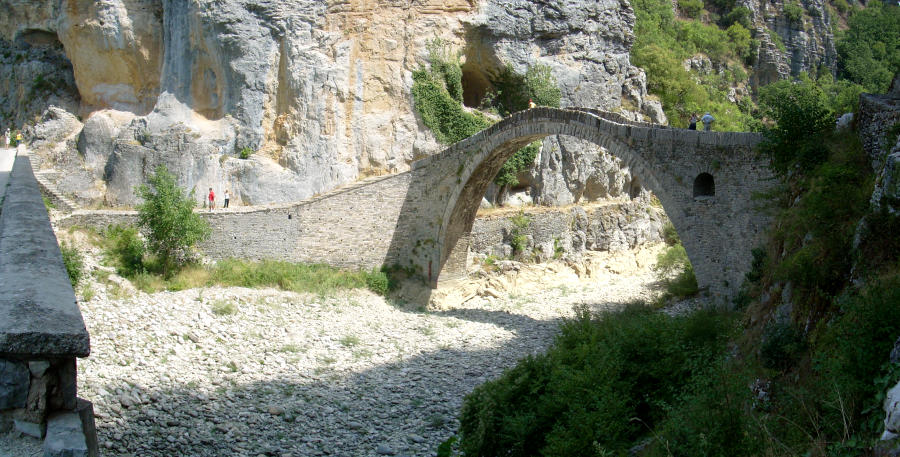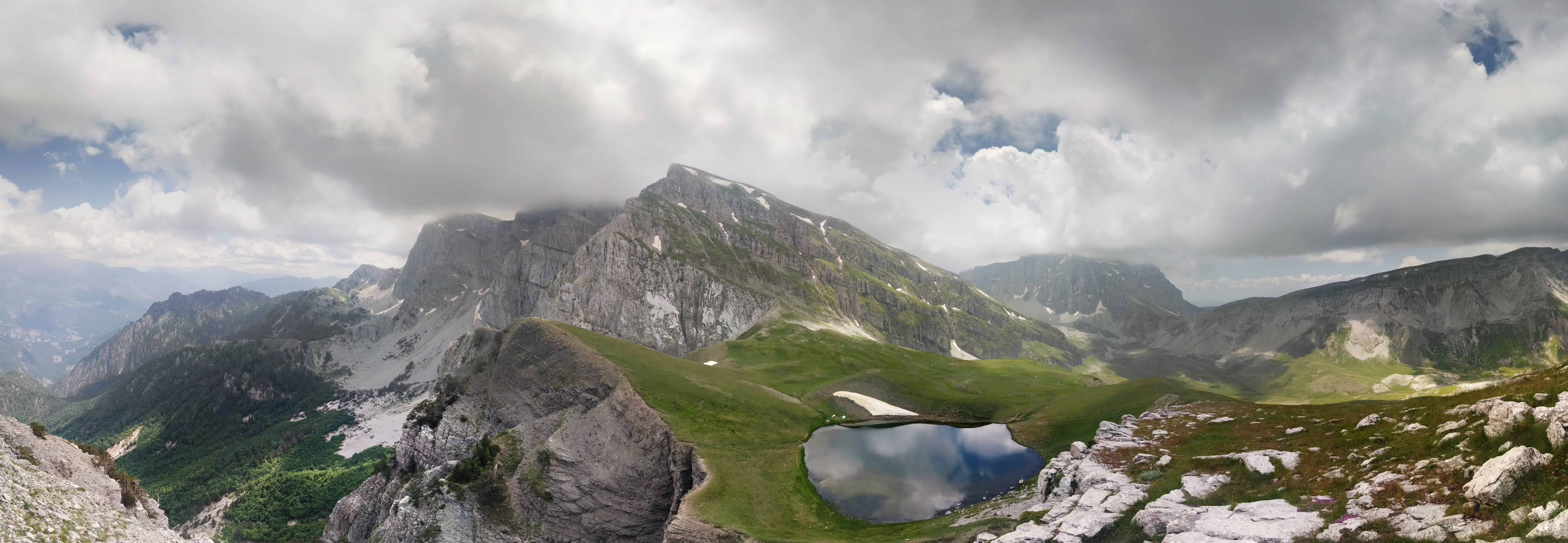|
Koukouli, Ioannina
Koukouli ( el, Κουκούλι) is a village of the Zagori region, in the municipal unit of Tymfi. It is situated at the southern end of the Vikos Gorge. History The village takes its name from the Greek word of silkworm cocoon; silk production in the wider region of Zagori was popular during the past centuries. The village appears to be founded somewhere in the 13th century. It was included in the treaty signed between the villages of Zagori (there were 14 at the time) and the Ottomans at 1430, which marked the beginning of Ottoman rule in the region. The villages of Zagori formed an autonomous federation for the next centuries. The privileges which were granted to the federation of Zagori and which are due, in the biggest part, to the influence of notable Zagorians over the Sublime Porte, were preserved until 1868. According to these privileges, Zagori was autonomous and self-governed under the surveillance of the Vekili of Zagori. Many inhabitants during the 18th century ... [...More Info...] [...Related Items...] OR: [Wikipedia] [Google] [Baidu] |
Epirus (region)
Epirus (; el, Ήπειρος, translit=Ípiros, ) is a traditional geographic and modern administrative region in northwestern Greece.Π.Δ. 51/87 “Καθορισμός των Περιφερειών της Χώρας για το σχεδιασμό κ.λ.π. της Περιφερειακής Ανάπτυξης” (''Determination of the Regions of the Country for the planning etc. of the development of the regions, Efimeris tis Kyverniseos ΦΕΚ A 26/06.03.1987'' It borders the regions of Western Macedonia and Thessaly to the east, West Greece to the south, the Ionian Sea and Ionian Islands to the west and Albania to the north. The region has an area of about . It is part of the wider historical region of Epirus, which overlaps modern Albania and Greece but lies mostly within Greek territory. Geography and ecology Greek Epirus, like the region as a whole, is rugged and mountainous. It comprises the land of the ancient Molossians and Thesprotians and a small part of the la ... [...More Info...] [...Related Items...] OR: [Wikipedia] [Google] [Baidu] |
Ioannina (regional Unit)
Ioannina ( el, Περιφερειακή ενότητα Ιωαννίνων) is one of the regional units of Greece. It is part of the region of Epirus. Its capital is the city of Ioannina. It is the largest regional unit in Epirus, and one of the largest regional units of Greece, with a population of 167,901 people, according to the 2011 census.GOV. results of permanent population 2011, p. 10561 (p. 87 of pdf), and in Excel formatTable of permanent population 2011 from the sitHellenic Statistical Authority 2017-11-24. Retrieved 2018-01-09. Geography Ioannina borders in the north, and the regional units of |
Zagori
Zagori ( el, Ζαγόρι; rup, Zagori), is a region and a municipality in the Pindus mountains in Epirus, in northwestern Greece. The seat of the municipality is the village Asprangeloi. It has an area of some and contains 46 villages known as Zagori villages (or Zagorochoria or Zagorohoria), and is in the shape of an upturned equilateral triangle. Ioannina, the provincial capital, is at the southern point of the triangle, while the south-western side is formed by Mount Mitsikeli (1,810m). The Aoos river running north of Mt Tymphe forms the northern boundary, while the south-eastern side runs along the Varda river to Mount Mavrovouni (2,100m) near Metsovo. The municipality has an area of 989.796 km2. The population of the area is about 3,700, which gives a population density of 4 inhabitants per square kilometer, very sparse when compared to an average of 73.8 for Greece as a whole. Geography Zagori is an area of great natural beauty, with striking geology and two Natio ... [...More Info...] [...Related Items...] OR: [Wikipedia] [Google] [Baidu] |
Tymfi, Greece
Tymfi ( el, Τύμφη) is a former municipality in the Ioannina regional unit, Epirus, Greece. Since the 2011 local government reform it is part of the municipality Zagori, of which it is a municipal unit. The municipal unit has an area of 428.296 km2. Population 862 (2011). The seat of the municipality was in Tsepelovo. It took its name from the Tymfi mountain. Subdivisions The municipal unit Tymfi is subdivided into the following communities: *Tsepelovo *Vradeto * Vrysochori * Iliochori *Kapesovo * Kipoi * Koukouli * Laista *Leptokarya * Negades *Skamneli Skamneli ( el, Σκαμνέλι) is a village in the Zagori region ( Epirus region), 54 km north of Ioannina. It is built in the fringes of mountain Tymfi (Mt Tymphe), at a height of 1160 m. Name The name "Skamneli" is of uncertain origi ... * Fragkades References Zagori Populated places in Ioannina (regional unit) {{Epirus-geo-stub de:Tymfi ... [...More Info...] [...Related Items...] OR: [Wikipedia] [Google] [Baidu] |
Tymfi
Tymphe (in Latin and English usage) or Tymfi (in the Greek government's preferred transliteration), Timfi, also Tymphi (, ) is a mountain in the northern Pindus mountain range, northwestern Greece. It is part of the regional unit of Ioannina and lies in the region of Zagori, just a few metres south of the 40° parallel. Tymphe forms a massif with its highest peak, Gamila, at . The massif of Tymphe includes in its southern part the Vikos Gorge, while they both form part of the Vikos–Aoös National Park which accepts over 100,000 visitors per year. The former municipality of the same name owed its name to the mountain. Etymology The exact meaning of the name is not known but has been in use since ancient times. The name "Tymphe" or "Stymphe" is mentioned by ancient geographer Strabo, Book 7, Ch. 7, and is associated with the ancient land of Tymphaea and the Tymphaeans, one of the tribes of Ancient Epirus. Despite its ancient use, the name does not appear in any descriptions of ... [...More Info...] [...Related Items...] OR: [Wikipedia] [Google] [Baidu] |
Vikos Gorge
The Vikos Gorge or Vikos Canyon ( gr, Φαράγγι του Βίκου) is a gorge in the Pindus Mountains of north-western Greece. It lies on the southern slopes of Mount Tymphe with a length of about 32 km, depth ranging from 120 to 1350 m, and a width ranging from 2500 m to only a few meters at its narrowest part. Vikos is listed as the world's "deepest relative to its width" gorge by the Guinness Book of Records among others. Etymology There are a number of views regarding the etymology of the name: *According to Ioannis Lambridis it derives from Slavic and means 'chasm' or 'gorge'. *According to Evangelos Bogas it derives from the Greek βίκος 'stamnos with ears', which denotes the shape of the gorge and the echoes caused by sounds within it. The word was recorded in the lexicon of Hesychius of Alexandria. *According to Konstantinos Amantos it derives from the Greek phytonym βικίον. *According to Konstantinos Oikonomou it derives from an Albanian word for ... [...More Info...] [...Related Items...] OR: [Wikipedia] [Google] [Baidu] |
Ottomans
The Ottoman Turks ( tr, Osmanlı Türkleri), were the Turkic founding and sociopolitically the most dominant ethnic group of the Ottoman Empire ( 1299/1302–1922). Reliable information about the early history of Ottoman Turks remains scarce, but they take their Turkish name, ''Osmanlı'' ("Osman" became altered in some European languages as "Ottoman"), from the house of Osman I (reigned 1299–1326), the founder of the House of Osman, the ruling dynasty of the Ottoman Empire for its entire 624 years. Expanding from its base in Söğüt, the Ottoman principality began incorporating other Turkish-speaking Muslims and non-Turkish Christians. Crossing into Europe from the 1350s, coming to dominate the Mediterranean Sea and, in 1453, invading Constantinople (the capital city of the Byzantine Empire), the Ottoman Turks blocked all major land routes between Asia and Europe. Western Europeans had to find other ways to trade with the East. Brief history The "Ottomans" first ... [...More Info...] [...Related Items...] OR: [Wikipedia] [Google] [Baidu] |
Sublime Porte
The Sublime Porte, also known as the Ottoman Porte or High Porte ( ota, باب عالی, Bāb-ı Ālī or ''Babıali'', from ar, باب, bāb, gate and , , ), was a synecdoche for the central government of the Ottoman Empire. History The name has its origins in the old practice in which the ruler announced his official decisions and judgements at the gate of his palace. This was the practice in the Byzantine Empire and it was also adopted by Ottoman Turk sultans since Orhan I, and therefore the palace of the sultan, or the gate leading to it, became known as the "High Gate". This name referred first to a palace in Bursa, Turkey. After the Ottomans had conquered Constantinople, now Istanbul, the gate now known as the Imperial Gate ( tr, Bâb-ı Hümâyûn), leading to the outermost courtyard of the Topkapı Palace, first became known as the "High Gate", or the "Sublime Porte". When Sultan Suleiman the Magnificent sealed an alliance with King Francis I of France in 1536, the ... [...More Info...] [...Related Items...] OR: [Wikipedia] [Google] [Baidu] |
Alexios Plakidas
Alexius is the Latinized form of the given name Alexios ( el, Αλέξιος, polytonic , "defender", cf. Alexander), especially common in the later Byzantine Empire. The female form is Alexia ( el, Αλεξία) and its variants such as Alessia (the masculine form of which is Alessio) in Italian. The name belongs to the most ancient attested Greek names (a-re-ke-se-u in the Linear B tablets KN Df 1229 and MY Fu 718). Rulers * Alexios I Komnenos (1048–1118), Byzantine emperor * Alexios II Komnenos (1167–1183), Byzantine emperor * Alexios III, Byzantine emperor * Alexios IV, Byzantine emperor * Alexios V Doukas, Byzantine emperor * Alexios I of Trebizond, Emperor of Trebizond * Alexios II of Trebizond, Emperor of Trebizond * Alexios III of Trebizond, Emperor of Trebizond * Alexios IV of Trebizond, Emperor of Trebizond * Alexios V of Trebizond, Emperor of Trebizond * Alexius Mikhailovich (1629–1676), Tsar of Russia * Alexius Petrovich (1690–1718), Russian tsarevich Re ... [...More Info...] [...Related Items...] OR: [Wikipedia] [Google] [Baidu] |
Second World War
World War II or the Second World War, often abbreviated as WWII or WW2, was a world war that lasted from 1939 to 1945. It involved the vast majority of the world's countries—including all of the great powers—forming two opposing military alliances: the Allies and the Axis powers. World War II was a total war that directly involved more than 100 million personnel from more than 30 countries. The major participants in the war threw their entire economic, industrial, and scientific capabilities behind the war effort, blurring the distinction between civilian and military resources. Aircraft played a major role in the conflict, enabling the strategic bombing of population centres and deploying the only two nuclear weapons ever used in war. World War II was by far the deadliest conflict in human history; it resulted in 70 to 85 million fatalities, mostly among civilians. Tens of millions died due to genocides (including the Holocaust), starvation, ma ... [...More Info...] [...Related Items...] OR: [Wikipedia] [Google] [Baidu] |
Manthos Iconomou
Manthos Economou ( el, Μάνθος Οικονόμου; 1754 – 22 August 1820) was a Greek member of the Filiki Eteria, private secretary and advisor of Ali Pasha of Ioannina. He was executed by the Ottoman troops. Biographical information Εconomou was born in 1754 in Koukouli of Zagori region.Sp. P. Aravantinos, ''Ιστορία Αλή πασά του Τεπελενλή'', Εκ του Τυπογραφείου των Καταστημάτων Σπυρίδωνος Κουσουλίνου, Athens, 1895, p. 461. Later, he settled to Ioannina in order to study at city's well-known schools. Due to his skills and personality, he was engaged in Ali’ s court, and soon he managed to become one of his most distinguished and trustworthy advisors. According to a theory,Sp. P. Aravantinos, 1895, p. 462. in 1807 he saved from certain death the notable Greek scholar and priest Konstantinos Ekonomos Economon when he was imprisoned in Ioannina. During the period 1817 to 1819, Economou was invo ... [...More Info...] [...Related Items...] OR: [Wikipedia] [Google] [Baidu] |






